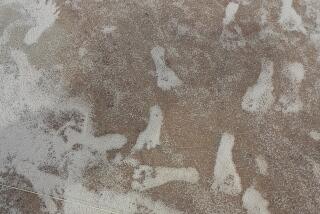New Archeological Dating Shakes Early American Migration Theory
- Share via
An archeological site in Siberia -- long thought to be the original jumping-off point for crossing the Bering land bridge into North America -- is much younger than previously believed, shaking the theory that the first Americans migrated overland during the final cold snap of the last great Ice Age.
Using radiocarbon dating, scientists found that the Ushki site, the remains of a community of hunters clustered around Ushki Lake in northeastern Russia, appears to be only about 13,000 years old -- 4,000 years younger than originally thought.
The new date places the Ushki settlement in the same era as the Clovis site, an ancient community found in New Mexico, making it highly unlikely that people could have traversed the thousands of miles from Siberia in such a short period.
“This was the last site out there in Siberia that could have been an ancestor for the Clovis,” said Michael Waters, co-author of the research appearing today in the journal Science. “We have to think bigger now and start thinking outside the box.”
History books have long presented the idea that the first Americans, perhaps hunting a herd of mammoths, crossed into North America across the Bering land bridge, a strip of land that is believed to have linked Russia and the United States 10,000 to 18,000 years ago. The land is thought to have been exposed during a period of glaciation when arctic ices locked away much of the oceans’ waters, making sea levels close to 400 feet lower than today’s.
“The new age assessments may indicate that archeologists continue to search in the wrong direction for an answer to Clovis origins,” said Anthony Boldurian, a University of Pittsburgh anthropologist who subscribes to the relatively new idea that the first Americans may have used boats to skip across Atlantic ice floes from Europe, entering North America perhaps as early as 20,000 years ago.
Other archeologists, such as Michael B. Collins from the Texas Archeological Research Laboratory at the University of Texas at Austin, believe that early humans from the Japanese archipelago followed whales and other marine food sources across the Pacific Ocean to North America.
“If you open up the possibility of water routes, even in the glacial maximum, they could skirt around the edge of the icepack in the North Pacific and come down the West Coast,” he said.
With the re-dating of the Ushki site, the oldest verified site near the Bering land bridge is now the 14,000-year-old Broken Mammoth settlement in central Alaska.
The Clovis site in New Mexico has yielded the earliest unequivocal archeological evidence that people were settled in North America 13,600 years ago. Archeologists also point to a variety of other locations, including sites in southern Chile and the mid-Atlantic region -- dating to over 12,500 years ago -- as evidence that the land bridge theory is faulty.
University of Kansas anthropological geneticist Michael Crawford said early humans probably could not have crossed the land bridge and traveled to New Mexico in 400 years. Reaching South America by foot within 1,000 years was even less likely, he said.
He believes that people may have entered North America across the Bering land bridge at an earlier point through multiple migrations. “Certainly the molecular genetics shows that it wasn’t just a single migration,” he said. Genetic research shows that “humans have been in America for at least 20,000 years.”
But some archeologists argue that due to the nomadic characteristics of America’s first settlers, the seemingly difficult feat of traversing the American continents in 1,000 years is not impossible.
“We are talking about tiny numbers of people, highly mobile, who would have traversed thousands of square miles as part of their hunting round within surprisingly few generations,” said Brian Fagan an emeritus professor of anthropology at UC Santa Barbara.
The Ushki, Clovis and other sites were given ages using radiocarbon dating. All organisms contain regular and radioactive carbon. Radioactive carbon decays in a known amount of time. Because dead plants and animals do not continue to take in radioactive carbon, the age of an organic sample, such as wood or bone, can be determined by comparing the amounts of each type of carbon remaining in the sample.
Radiocarbon dating may confirm that many other early American sites are pre-Clovis settlements.
This possibility, combined with the fact that earlier Siberian sites have not been found, has left archeologists and anthropologists “scratching their heads,” Waters said.
More to Read
Sign up for Essential California
The most important California stories and recommendations in your inbox every morning.
You may occasionally receive promotional content from the Los Angeles Times.










